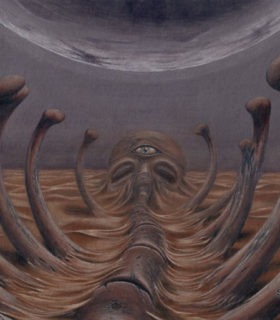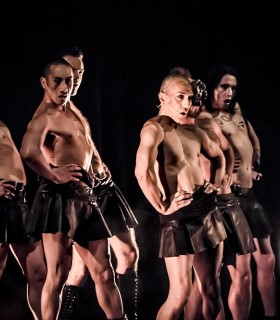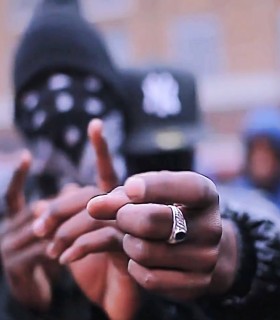Many have been patiently awaiting the release of my newest recording. After four years in the works, it finally saw the light of day this past October. The Memento Mori EP is different than any record put out in the last 30 years. Before I explain why, here’s a quick history lesson. Being a huge fan of Einstürzende Neubauten, Test Dept, Crash Worship, and Z’ev — plus having found access to subway tunnels, as well as abandoned buildings in Brooklyn and Manhattan — I thought to gather groups of friends there, and record what I could. For the last five years, that project has been performing, and recording music, under the name 156. Since then, a handful of friends have collected human bones (skulls, femurs, vertebrae), and in handling the remains, the idea arose to begin using them in my music.

Most bones can only be used to strike objects, over making sound themselves, and I found it a perfect fit for what 156 was already doing. At first, the idea was to use the bones along with what’s normally used in this project (metal, glass, and concrete), but the concept soon developed into using nothing but the bones, or the human breath passing through them. Thus, the Memento Mori sessions began…
http://www.youtube.com/watch?v=W__mhP3C-WU
Not wanting to have our “instruments” confiscated, many of the get-togethers were recorded in the safety of our homes, though a handful were successfully captured in a few darkened crevasses throughout the city.
When I began to curate this release, I had thought of Zero Kama’s 1984 LP, The Secret Eye of L.A.Y.L.A.H., and Metgumbnerbone’s Ligeliahorn, album from 1983, though they were not a main influence, seeing both made instruments out of human bones, but used them only in part with other instruments/objects. The Memento Mori EP was recorded strictly using only bones, and did so from first strike to last.
The main recording sessions ran from late-2012 through late-2014, mostly due to the scarcity of what was used, plus the back and forth of borrowing the equipment - not to mention that some of the early recording sessions were unusable. Besides my friends’ assortments, I began to purchase a few to stop the constant borrowing - the largest I now own being a complete pelvis.
By early-2015, the foundation of all the tracks, along with effects I felt filled in the bare bones clamor of simple clacking, were finally done. Yet, needing to fill out the sound more, I saved up to buy a Tibetan kangling (a femur cut and drilled so as to produce the sound of a horn), which turned out to be the most expensive of all that was purchased. It took quite a long time until getting my hands on an authentic one, as most for sale are actually yak bone. The kangling was the most difficult to operate, because I thought simple appliance would be enough, and didn’t know one needed to learn how to properly play it.
The final editing came in late-2015, and the EP was then mastered by James Plotkin – for, both, a vinyl and digital version.
Much of 156 has an industrial drum circle type of sound, similar to previously mentioned acts like Crash Worship or early Neubauten, which tends to be hypnotic. A number of ritualistic components came together within this release, most notably, the exclusive use of human bones to produce the music, and the broader themes which inspired it.

The original title wasn’t planned as Memento Mori, but by the time the recordings were nearly complete, this name for these sessions had been used to the point that it stuck as a title for the recording. This title had initially been chosen because the end result is meant to be the object used in a reflection on mortality in the practice of “memento mori”. The theory and custom, mostly used today in Masonic lodges and chivalric orders, stems from the Renaissance discipline of “ars moriendi” (“the art of dying”), and was inspired by Plato’s dialog Phaedo, as well as letters by Seneca in the instruction to arbitrate on death. While the Buddhists have been doing it for over a thousand years (hence their use of the kangling), for the last few centuries Europeans have been employing skulls in the ritual practice where they sit in a candlelit room, stare, and meditate on things like the limits of time, earthly vanity, dying well, but also living a good, and just, life. 156’s Memento Mori EP is meant to be an audial replacement of the skull normally used, for those who cannot afford one, or prefer sound to sight, when in contemplation.
The first rack off the Memento Mori EP is “Kokoro”, which is Japanese for “the heart of things”, and gives the uninitiated a perfect tone for what to expect.
http://www.youtube.com/watch?v=9_CYJAIsIsc
Side two of the 10” EP begins with “Me-Olam, Ad-Olam”, which translates to “from this world, to the next world” in Aramaic. I recently finished shooting a new music video for the track, and it was filmed in the abandoned machine shops of Fort Tilden in the NYC borough of Queens.
http://www.youtube.com/watch?v=QWTRMX2eRZw&t
The Memento Mori EP has been released in two formats. The 10” bone-colored vinyl - released in a limited edition of 489 copies - contains nine songs, but is playable at two speeds; 45 rpm to hear the original recordings, and 33 rpm to hear what are called the Thunderdrone Versions, which are to be played during rain storms. The digital format (available in mp3 or FLAC) holds all eighteen versions heard on the 10” EP.
Whether you use this collection for personal liturgical purposes, or simply listening enjoyment, it will surely send chills down your spine.
Adel Souto is a Cuban-born, Miami native currently living in Brooklyn, which makes him one hell of a mixed up writer, artist, musician, and troublemaker. Adel likes to walk where angels fear to tread, drive people insane, and fly off at a moment’s notice. His website can be summoned by demonic magic, or by just typing his full name into your browser.


